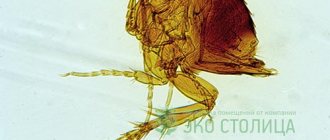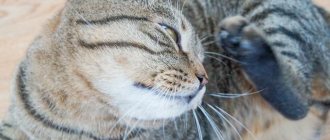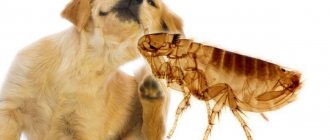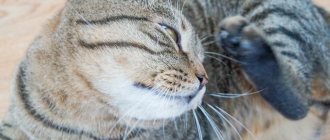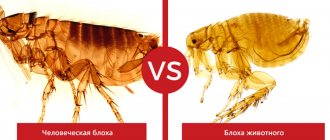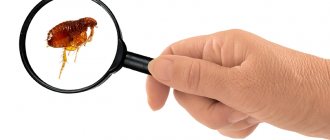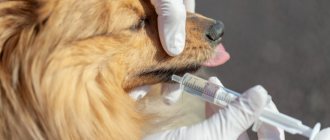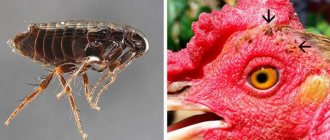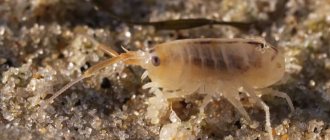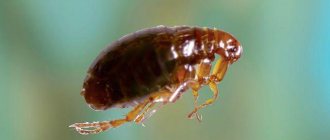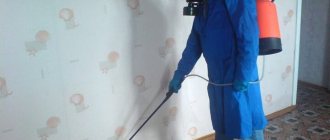Unfortunately, fleas in cats are a common occurrence. Moreover, they can even develop in animals that never leave the apartment. These pests bite pets, cause them pain, and can also infect them with dangerous diseases. Fleas in cats can and should be dealt with. For this, there are both folk remedies and specialized drugs. They have different effectiveness and duration of action, but among all the variety you can choose what will work in a specific case and with a specific cat, taking into account his personal characteristics.
Why and how cats get fleas
A flea is a small blood-sucking insect, the size of which does not exceed 3 mm. She has a flat body and paws with spikes, and the paws are of different lengths. The hind ones are especially long and powerful, they allow fleas to jump a very long distance - half a meter. Considering the size of the flea itself, this is about the same as a jump of two hundred meters for a person.
Fleas are parasites; they live on animals whose blood they feed on.
They easily jump from one victim to another, so it is very easy to pick up fleas while walking. But not all domestic cats go for walks. Many of them never leave the apartment. And even in this case, you can get a parasite. Where do fleas come from in a domestic cat?
- from other animals if they enter the house;
- from owners who can bring insects on their clothes, in a bag of groceries, household items and on shoes;
- from neighbors, from the common corridor and common areas, from where fleas can get there on their own.
Even if you maintain an almost sterile cleanliness in the house, there is no absolute certainty that your cat will not pick up fleas.
Wild animals
A house cat is not going to stalk prey in the wilds of neighboring gardens, but you may be surprised to learn that they may have the opportunity to hunt in your home.
Wild animals, especially rodents, can get inside, especially if you live in a rural area or have a garden, basement or attic. While these critters are unlikely to want to stay within reach of a healthy cat's claws, rats, mice and the like are breeding grounds for fleas. Of course, it's possible, especially if you end up infested, that they could drop flea eggs in the house, which then hatch and get to your cat.
Cats themselves repel rodents, but you can help too by clearing food and waste from counters. Make sure your kitchen trash can has a heavy-duty lid, empty it regularly, and store it outside. Food scraps should be immediately put into a compost heap, if you have one, or thrown away.
If hungry invaders are still a problem, check your home for possible entry points, seal gaps in doors and windows, and install screens on ventilation and plumbing openings. You may find it helpful to consult a pest control professional to advise you on preventive measures.
Why are fleas dangerous?
These pests feed on the blood of animals. They bite through the skin and suck out blood. In this case, substances are injected into the wound, which prevent the blood from clotting quickly and also cause severe irritation. Flea bites are very itchy, the cat is constantly itching, scratching the wounds, which easily become infected. Fleas bite a wide variety of animals, so they are carriers of pathogens of dangerous diseases. Some of them can be fatal or lead to serious consequences.
Cat fleas do not live on humans, but in the absence of a familiar and more suitable victim they can bite people, which is also dangerous.
Cat flea: who is it and where does it come from?
To understand where cats get fleas from, you should learn more about these parasites: their structure, feeding habits, and life cycle. Fleas are a huge order of wingless insects that are blood-sucking exoparasites and parasitize on any animal. They have a rather narrow specialization: there are fleas of rabbits (Spilopsyllus cuniculi), dogs (Ctenocephalus canis), humans (Pulex irritans) and cats (Ctenocephalides felis). These insects also parasitize rats and birds. Outwardly, they are very similar; only a professional entomologist can determine the exact type of insect.
general description
What does a flea look like on a cat? Their body size ranges from 1 to 5 mm, the cat flea reaches approximately 2 mm. Males are smaller than females. The parasite that has sucked blood increases sharply in size—approximately 2 times. The insect's body is flattened laterally (this makes it easy to move between hairs) and covered with numerous spines and bristles. They help the insect to stay between the hairs of fur or feathers.
The oral apparatus of the parasite is of the piercing-sucking type, which includes a special stylet that pierces the skin of the host. They do not have a proboscis. The limbs of the parasite are strong, they give it the ability to move along surfaces at any angle, as well as make long jumps. The abdomen has special tactile hairs that are sensitive to air vibrations.
They are wingless insects - with their lifestyle, wings would only get in the way of the parasite. The shape of the body and the chitinous cover make mechanical damage to the insect very difficult - it cannot be crushed with your fingers. The parasite can only be destroyed by crushing it with a fingernail on a hard surface.
This is interesting! Fleas are one of the best jumpers in the animal kingdom. Having a size of only a few millimeters, they can jump 19 cm in height and 30 cm in length. This is a hundred times the size of their own body. A person, in order to repeat these results, must long jump 160 meters.
Life cycle
Fleas are insects with a full life cycle; they have the stages of adult insect, egg, larvae and pupae. The female lays her eggs anywhere, and after about two weeks a worm-like larva appears, which grows and molts several times. The larvae live in dust and debris, feeding on decaying organic matter and excrement.
Later, the larva pupates and after a while emerges from the pupa as an adult insect. Now she just needs to find her owner.
The insect's lifespan is approximately 2 years. Parasites reproduce very actively; during her life, the female lays up to 2 thousand eggs.
Cat fleas can also spread to rats, and they displace the rat flea.
Eating habits
Each type of parasite prefers its own host. They adapt to a certain skin structure, its temperature, the composition of the host’s blood and other characteristics. They can feed on the blood of other animals, but they do not do this very willingly.
Although, it should be noted that in this regard the cat flea is the most picky, as it can easily drink both dog and human blood. She is the champion in the number of bites to people.
Typically, these insects do not live permanently on their host. Rather, it serves as their dining room. They attack him from time to time, drink his blood and leave again. They live near their owner. There are some types of fleas that live permanently on their host; these are parasites of nomadic animals.
They feed daily, but can easily endure several months of fasting, after which they pounce on food with particular greed.
This is interesting! Fleas have changed little over the past 50 million years. The fossil insects that scientists studied are almost no different from modern ones. Evolution, apparently, considered that it had already created a masterpiece, which did not make sense to change.
Diseases
Fleas are carriers of serious diseases in humans and domestic animals. Rat pests are especially dangerous. They carry plague, typhus and other serious diseases. In the Middle Ages, entire cities died out from plague epidemics transmitted by rats.
Fortunately, the cat flea does not carry such dangerous diseases, but other types of these insects can live on your pet.
Symptoms of fleas in a cat
It is quite simple to understand that a cat is overcome by fleas. You need to keep an eye on your pet. The following signs indicate the presence of parasites:
- the animal is constantly itching;
- there are small wounds on the skin with dried crusts;
- small black dots can be found in the fur - these are insect excrement;
- You can also see the fleas themselves - they move along the coat, undercoat;
- the animal becomes nervous, restless, sleeps poorly, often wakes up to scratch itself, and its appetite worsens.
How to check a cat for fleas?
After carefully examining the animal, it is easy to verify the presence or absence of fleas. To do this, you need to use a wide-toothed comb, and, spreading the fur, carefully examine each area of the skin. The presence of cat parasites will be indicated by red spots, irritated skin of the pet, as well as traces of parasite activity - small flesh-colored eggs, dark dirt and pieces of dried blood. If the examination of the pet does not yield results, but its behavior is restless, then you can do it differently: using a slicker brush, comb the animal and place the resulting contents on a sheet of white paper. The detection of small black dots indicates the presence of flea excrement.
Once you have confirmed the presence of blood-sucking parasites, you must immediately begin to fight them, as they serve as carriers of various dangerous infections and can cause allergies in people.
Flea removal methods
Insecticides are used to kill insects. These are industrially produced preparations, they are offered in different forms: sprays, drops on the withers, shampoos, collars. They are quite effective, but can also be toxic to the animals themselves. That is why they should not be used to remove fleas from pregnant cats, weakened kittens, and older animals. These drugs can also cause an acute allergic reaction.
Less toxic, but also not as effective, are folk remedies for flea control. In addition, some of these methods are quite complex to implement and require repeated or regular use.
Pharmaceutical preparations for fleas
These include funds in different forms:
- shampoos;
- sprays;
- drops;
- pills.
The choice of product depends on the degree of flea damage, the condition of the animal and the ability to use one or another drug. It's no secret that washing cats is a very difficult task.
Shampoos
The most popular flea remedy. It is relatively safe, but at the same time effective. Shampoo helps get rid of fleas if their number has not reached a critical level, when the entire undercoat is literally swarming with insects. At the initial stage, one wash with a specialized shampoo will be enough.
You can add Ectometrin from Medilis to your regular animal shampoo at the rate of 2 ml per 200 ml of detergent.
Important: you need to use an anti-flea shampoo designed specifically for cats. It is also very important to rinse the wool thoroughly after washing, without leaving even the slightest trace of shampoo on it.
There are flea shampoos that can be used on small kittens.
Sprays
A more convenient drug to use. It can be sprayed outdoors or in a ventilated area. At high concentrations, aerosols are toxic to both the pet and the owner. Flea sprays are only suitable for short-haired cats. With long hair, the drug simply will not achieve its goal.
Alternatively, you can use Ectometrin emulsion from Medilis. It is diluted according to the instructions, applied to the wool with a swab so that the product is absorbed into the skin, and not just into the wool.
Important: when processing, you need to put a cervical collar on the cat so that he does not lick the drug from the fur. It is also necessary to protect your eyes and nose from contact with the insecticide.
Drops
Another popular remedy. It is suitable for treating cats with fur of any length and thickness. Drops are applied to the animal's skin at the withers. Not even the most flexible animal can lick them off the withers. But if there are several animals in the house, they can lick each other, so when processing it is important to separate them to prevent poisoning.
Important: choose drops from trusted manufacturers. These can be “Stronghold”, “Broadline spot on”, “Advocate”, “Advantage”, “Frontline combo”, “Vectra”, “Rolf”. Make sure the product is intended for flea control in cats. It is necessary to strictly follow the instructions and not exceed the prescribed concentration. It is also important for the owner to take care and not allow the product to get on his hands.
Tablets and solutions for injections
This method of control is less known, but there are flea medications for oral administration. Getting into the blood of a pet, they do not harm it, but become destructive for fleas that drink this blood. Flea tablets are usually given to the cat before deworming.
Feeding a cat a pill is quite a difficult task. Therefore, solutions for injection have been developed. The injection must be given by a veterinarian in a clinic setting. It is important to take the appropriate drug and calculate its dose.
Signs of bites
Flea bites are quite noticeable and unpleasant
It is very important to learn to recognize them in order to begin disinfection in time. After all, insects will not go away on their own: they multiply very quickly and begin to live in:
- cracks;
- carpets;
- sofas;
- bedding.
Here are some obvious signs that you have been bitten by a flea:
- At the moment of the bite, you will feel a prick on your skin, which is much more painful than a mosquito bite.
- Later, red dots may be seen on the skin. Sometimes the blisters swell and the skin around them turns red.
- The affected area is very itchy, causes a lot of trouble and constantly reminds you of itself.
- The bites are approximately 1–2 cm apart. But these are not straight paths, as happens if bedbugs live in the house.
- Insects usually bite legs, since their jumps do not exceed half a meter. But if they settled in the bed or jumped into it, they can bite the whole body.
Depending on the sensitivity of the skin and the characteristics of the human body, the marks after bites can be different: small, invisible or blurred, very large. But they will still disappear in a few days, so there is no need to be afraid.
Using flea collars
A very popular remedy among cat owners. The collar is impregnated with special preparations that repel fleas. It is effective, but its range of action is very limited, that is, it protects the front of the cat, while the back remains unprotected. It is important that the collar is intended specifically for cats, otherwise the dosage may be too high and the drug may be toxic. Collars need to be changed promptly, as they are valid for no more than a month. You also need to consider that collars can irritate the skin and cause allergies.
A type of collar is a flea keychain for a cat. It is hung on a collar or placed in a house or on a bed where the cat is used to lying. The key fob is battery operated. It emits ultrasound, which is not dangerous to the cat, but repels fleas within a meter radius.
Prevention and treatment
As previously noted, if fleas are detected on a cat, treatment must be started immediately and comprehensively. In most cases, the course involves completing the following stages:
- external influence on parasites through the use of drops, shampoo or aerosol;
- preventative treatment to prevent the next generation of pests using collars or oral medications;
- cleansing the cat’s skin after it has been treated for parasites;
- conducting a course of taking vitamins and preparations containing sulfur to completely cure the animal and restore the coat and skin;
- carrying out ozone therapy (if the owner wishes), or treatment with hormonal ointments that cure skin inflammation and itching in the cat.
Naturally, before using any drug, you need to consult a veterinarian. However, even with this approach, it is not completely ruled out that the animal’s body will not be too sensitive to the chosen remedy.
It is important to note that it is strictly forbidden to use several products at the same time - this will be bad not only for the dying parasites, but also for the animal itself.
Traditional methods of fighting fleas
Fleas have been pestering pets for a very long time. During this time, many methods of combating them have emerged. Most are safe for pets, but many are not very effective.
There are also more toxic options. For example, remembering that people used to get rid of lice with kerosene, someone is trying to use it against fleas. This should not be done under any circumstances. This leads to serious poisoning and death of the animal.
Most often, cats are bathed in a decoction of wormwood and rosemary, and soap with wormwood is used for washing. If there are a large number of fleas, these remedies do not help. After using all types of soap, it is important to thoroughly rinse the fur so that your pet does not ingest harmful substances.
Other folk remedies for fleas in cats:
- Bathing in salt water (100 grams of salt per liter). The cat should be placed in a bowl of salt water so that the entire head is on the surface. You need to keep the animal in a salt bath for 10 - 15 minutes, then rinse the fur thoroughly using regular baby soap, dry it and comb it thoroughly to remove dead fleas. The procedure is repeated after 5 – 7 days. Several treatments may be needed. Salt baths can be used to remove parasites from kittens and pregnant cats.
- Treatment with tar soap. You can take liquid soap or lather a solid bar. You should get a thick foam, which is applied to the cat’s entire body and left for 15 minutes, after which the cat can be wrapped in a thick towel. To prevent parasites from scattering around the apartment after removing the towel, it is better to keep the cat in the bath. After the required exposure time, the cat is thoroughly washed, dried and combed. The procedure is repeated a week later.
- Essential oils. They don't kill parasites, but they repel them. Oils with strong odors also do not destroy the eggs that fleas have laid in the fur. The oil is used only in diluted form: 3 – 4 drops are diluted in a glass of water. This water is applied to the cat's fur, trying to saturate the entire coat of the animal down to the skin. You can use oils of pine, cedar, eucalyptus, wormwood, lavender, and anise. You can use essential oils with caution to remove fleas from kittens and pregnant cats, but you need to make sure that the animal does not have individual intolerances or allergies. At the same time as treating with oils, you need to carefully comb out the cat's fur. This way you can reduce the number of fleas by simply removing them mechanically, as well as remove eggs and larvae.
- Wormwood decoction. This plant has a very pungent odor that parasites do not like. Prepare the tincture by pouring five tablespoons of dry leaves into a liter of water and bringing to a boil, simmering over low heat for 20 minutes. The broth is cooled, filtered and the wool is generously moistened with it, then the animal is wrapped in a terry towel for 15 - 20 minutes. Then the wool is washed, dried and combed. This product also does not destroy larvae and eggs; they need to be combed out. A decoction of geranium leaves also works. Both remedies must be used several times.
- Homemade flea shampoo. Take liquid tar soap or diluted in water, add egg yolk, finely chopped onion and wormwood decoction to it. You should get a paste that is applied to the moistened coat, rubbing it into the skin. Then the cat is wrapped in a towel for 20 minutes. After exposure, the wool covering is thoroughly washed and dried, then also thoroughly combed.
Insect development cycle
A flea is a small insect without wings that belongs to the blood-sucking order. Typically the size of these parasites is 5–6 mm. Their body, flattened on the sides, has a brown color and a characteristic shine. It is covered with tiny bristles and spines, thanks to which insects are able to move quickly and stay in the fur of their owners.
Fleas are insects with complete metamorphosis. Their life cycle is similar to the developmental stages of a butterfly and consists of the following stages:
- Egg. Flea eggs are so small (from 0.5 to 1 mm) that they can only be noticed upon careful examination. The average duration of egg development under favorable conditions is 2 weeks. Flea eggs can usually be found in carpets and floor crevices, as well as behind baseboards.
- Larva. At the end of the maturation process, larvae emerge from the eggs, which feed on skin particles, blood debris, excrement of adult insects and other decomposing debris. Flea larvae look like translucent, mobile worms with dark spots inside. This spot is the esophagus of an insect with the remains of eaten food. At the end of their growth and molting period, the larvae reach 4–5 mm. This process usually takes 3–4 weeks, after which the larva pupates.
- Doll. After the larva develops into a pupa, it forms a silk-like cocoon around its body. Under favorable conditions, an adult insect will be born within 7–10 days. If environmental conditions are not very suitable for the emergence of an adult, it can wait up to a year for the right moment. This stage of flea development is considered one of the most tenacious. In the pupal stage, the insect easily tolerates cold and exposure to insecticidal preparations in normal concentrations.
- Adult (imago). When favorable environmental conditions occur, adult individuals (imagoes) emerge from the pupa, ready for reproduction. However, in order for mating to be successful, both the female and the male must be well-fed. At the end of the fertilization process, the female immediately begins to lay eggs, but she does not look for a special place for this. Fleas release eggs over fairly long distances as they move, which increases the survival rate of their offspring.
Interesting! A well-fed and healthy flea can lay up to 30 eggs a day, although it usually only has enough strength for 4-10 eggs. During its entire life, the adult lays approximately 500 eggs.
What else needs to be done at home
If not only the animal is infected with fleas, but also the apartment in which it lives, the entire home must be treated. Eggs and insects may be present in the cat's bedding or house, on clothes and shoes, and household items. Therefore, along with treating the cat, it is necessary to disinfest the apartment.
Before processing the apartment, a thorough cleaning of the room is necessary. Wash at a temperature of 60 degrees all textiles that can be washed: curtains, bedspreads, blankets, rugs, pillows. It is also advisable to iron all textiles or fry them in the sun. If possible, it is better to treat everything with a steam cleaner. You need to wash all your shoes, wash or dry-clean your outerwear, hats, and scarves.
Then they are treated with an insecticide. It can be in the form of a spray or solution for spraying and wiping surfaces. It is sprayed throughout the room, especially attention should be paid to baseboards, floors, and furniture standing on the floor. It is also advisable to treat upholstered furniture. To treat premises against fleas, you can use insectoacaricides from Medilis: Malathion, Permifen, Super, Cyper, Neo. They destroy not only fleas, but also other parasites unwanted by humans. However, it is necessary to strictly follow the instructions when preparing working solutions and using them.
After the exposure time specified in the instructions has passed, furniture, carpets, floors and other surfaces are vacuumed to remove dead insects. After this, you can wash the floors and other surfaces with water with the addition of strong-smelling essential oils, such as pine or wormwood.
All processing is carried out observing safety precautions. There should be no animals or people in the room. After applying the product, you need to leave the apartment for several hours, and then thoroughly ventilate the entire apartment.
Used items
Pets love to sleep on our upholstered furniture, whether snuggling up on the sofa or snuggling up on the pillows. The problem is that when a pet has fleas, large numbers of eggs can fall from their fur into the environment, especially in areas where they rest, sleep and play.
While your cat may not be contaminated, second-hand products may be! Keep this in mind when returning bargains from thrift stores, flea markets and even antique stores, and do a thorough cleaning. Any upholstered furniture should be hot washed and, if possible, tumble dried, and other items such as furniture and luggage should be wiped down to remove any potential flea eggs.
How to remove fleas from a pregnant cat
Pregnant and lactating cats also suffer from fleas. They must be removed, as infection with parasites affects the development of kittens. It is important that the products are non-toxic. It is better if the drug is selected by a veterinarian after assessing the animal’s condition. For treatment, sprays or drops are used on the withers. The preparations must contain an indication of the possibility of use on pregnant and lactating animals.
Shampoos, drops on the withers and sprays are also used to treat kittens. There are products that can be used within a couple of days after the kitten is born.
Preventing flea infestation
There is no absolute protection against fleas. But you can reduce the likelihood of infection. To do this, you need to take the following measures:
- for prevention, apply drops to the withers every two months or six months, as indicated in the instructions;
- do not let the cat go outside;
- regularly take the animal to the veterinarian, who can detect parasites in time.
If it is known that there are fleas in the house, which is especially true in older buildings, it is worth using pest control products to treat the apartment from time to time.
If a cat walks outside, it makes sense to vaccinate it. Once a year, a vaccination is given that protects the pet from pests. Vaccination is done only in a veterinary office.
Review of effective remedies
It is not always possible to independently select a suitable flea drug in the form of drops, since their range is quite extensive. Analyzing information from manufacturers, reviews, and the opinions of veterinarians, we can identify several popular brands that meet the criteria of safety and effectiveness.
Foreign manufacturers
- Hartz. American-made drops destroy flea larvae and oviposition. They should not be used on kittens under three months of age. Apply the product to the occipital area. The effect of the drug lasts for a month, after which the procedure is repeated. The protective effect is not reduced by short-term exposure to moisture. A preliminary consultation with a veterinarian will be required regarding the use of drops for pregnant cats, aging, and sick animals.
- Beaphar. In the line of Dutch-made flea drops, you can choose varieties for kittens and adult cats, including weakened and pregnant ones. The active ingredient is a natural margosa extract that is safe for animals. Convenient packaging in disposable ampoules is offered. The contents are poured onto the withers, lightly rubbing into the skin. By repeating the procedure every 30 days, you can completely protect your pet from fleas.
- Frontline. Due to the low degree of toxicity, drops produced in France by Frontline are approved for kittens from the age of two months. Formulations are used for cats, packaged in disposable pipettes with a volume of 0.5 ml. This drug is also used to rid animals of ear scabies. It must be taken into account that after processing light-colored breeds, the wool can change its original color.
- Advantage. When considering the best drops aimed at killing fleas in cats, it is necessary to note the German drug Advantage, the base substance of which is imidacloprid. Sold in tubes, the contents of which are squeezed onto the withers once a month. The drug is approved for kittens from two months. After treatment, it is necessary to ensure that small pets do not lick the insecticide within three hours.
- Advocate. These are effective drops made in Germany, which have proven themselves as an effective preventive measure. The drug Advocate is contraindicated in weakened animals and kittens under nine months of age.
- Zookeeper. The Belarusian-made drug is distinguished by lasting results after treating cats against fleas. Allowed for kittens two months old. Not recommended for weakened pets.
There is a type of drops that are part of a series of biological products. These include the German-developed Green Fort drug. It is safe because it contains natural ingredients. But it should be borne in mind that the effect of these drops is aimed only at repelling fleas. Therefore, they are more often used as prophylactic agents.
Russian-made drugs
- Bars drops, aimed at cats, have received the most widespread recognition. They destroy larvae and have a detrimental effect on insect eggs, maintaining the effect for almost three months.
- Dana-2 Ultra. The active component is low-toxic fipronil. These drops act quickly and effectively, but are recommended only for animals older than one year.
- The barrier is super. A drug that quickly destroys all generations of fleas. Allowed for kittens over three months old. The duration of exposure lasts two months.
- Inspector. Insecticidal drops that can destroy not only fleas, but also helminths. Prohibited for cats if skin damage is detected. Veterinarian permission is required for use by pregnant females and kittens weighing less than a kilogram.
- Celandine drops can be used by kittens from two months. The dosage is determined in accordance with the instructions and depends on the weight of the animal. If it is below 2 kg, then squeeze out half the contents of one pipette, that is, 0.5 ml. Pets from 3 to 5 kg require 1 ml, and over 5 and up to 10 kg - 2 ml. It is recommended to apply drops to the skin between the shoulder blades. The drug is prohibited for weak, sick animals, and pregnant cats.
Timely measures taken to combat fleas will save cats from serious consequences, such as hair loss, infection with dangerous diseases and allergic manifestations. Modern drops quickly rid animals of blood-sucking insects and show high effectiveness as preventative agents.
